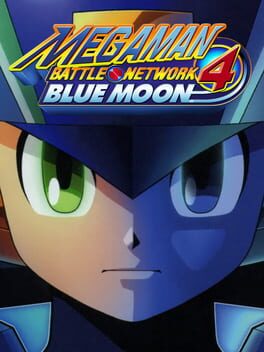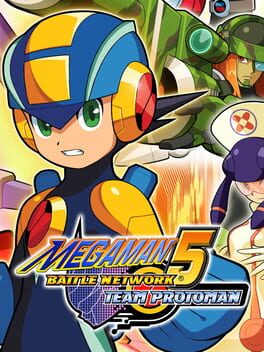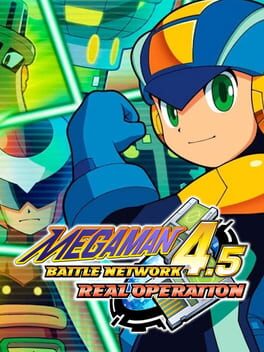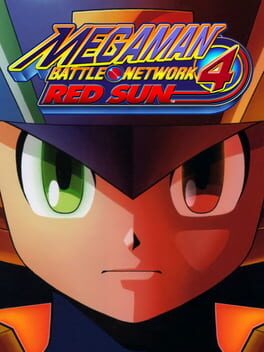

Mega Man Battle Network 4: Blue Moon
released on Dec 14, 2003
The fourth installment in the Mega Man Battle Network series comes in two versions--Red Sun and Blue Moon--each with different enemies, battle chips, souls, and characters. Once again, you assume the role of Lan as he and his friend, Mega Man.exe, fight to rid the Internet of viruses and other cyberworld enemies. Unlike previous games in the series, Mega Man Battle Network 4 focuses on a tournament system where players encounter a variety of enemies that must be defeated. A new Soul Unison system lets Mega Man transform into his defeated enemies.
Also in series
Reviews View More
Returning to a franchise as esteemed as Megaman holds much excitement. Despite its growing pains, the Battle Network games have provided much joy and excitement for their innovative gameplay and storytelling. Even a game as unrefined as the first Battle Network has much to offer as a foundational start for the series. With each game improving upon the last, it’s only natural to be excited for the fourth installment. This is especially true when considering the success of Battle Network 3. Megaman Battle Network 4: Blue Moon brings an overhaul to the visuals, restructures ACDC Town, new features like Double Soul and dark chips, and a combination of old and new boss Navis. All of this culminates in the series’ greatest failure.
Immediately when you start the game you will see a significant change in the art direction. The sprites are more detailed and the perspective feels slightly zoomed in. Each character’s portrait and sprite remain the same in spirit but some have different expressions. The overhaul of ACDC Town was the most jarring change. Some houses were removed, Yai’s house was moved and made bigger, and the locations of Higsby’s shop, the park, and the train station were all relocated. This condensed the town by removing about a third of the space within it. There’s no rhyme or reason behind it, it’s just different for what feels like the sake of being different. These changes don’t necessarily hurt the game but drastically changing the most known location becomes a contributing factor to the game’s other failings; starting with the story.
Battle Network 4’s story is essentially a tournament arc where Lan and Megaman participate in three tournaments while an asteroid is hurtling toward Earth. The missions between the Navi fights were daunting and served zero purpose other than giving you something to do. The story often would introduce a point of conflict and then quickly undermine it. The first example of this is the introduction of AquaMan. AquaMan overhears a conversation where he is led to believe that his operator is going to discard him for a new Navi. The conversation made me feel bad for AquaMan but then you almost immediately find out that they weren’t talking about him at all. The story does this a few times where the “danger” was a misunderstanding or a plan to gain respect/admiration gone wrong. Each tournament gives you three randomized quests to complete while they drip-feed you what’s happening with the meteor. All of these missions feel empty because they have no bearing on the story. The problem with randomized quests is that because they have to fit the story regardless of which ones you get, they ultimately end up being nothing but a means to force more journeys into the net on you.
You’re introduced to the net very quickly, and the seemingly endless forays into the same bland net spaces begin. Battle Network is no stranger to running through net spaces but Battle Network 4 takes it to another level of constantly jacking in, running to a place, jacking out, completing an objective, and then having to jack back in again to go exactly to where you just were. I think I had the layouts of ACDC and ElecTown’s net spaces memorized before I finished the first episode of content. This persists throughout the narrative as you are only given three proper dungeons to explore. One of which is so linear that it’s literally on rails. The other two were incredibly limited with only one of them requiring you to figure out navigating due to the nature of the puzzle. By the time I reached the third and final dungeon, I was ready for the game to end. I hurried to get through it as quickly as possible so I could fight the last few bosses at the end of the game.
Battling the various Navis throughout the game was the game’s greatest opportunity to show off the good aspects of Battle Network 4. This is where you can experience the Double Soul mechanic where Megaman takes on attributes of Navis that he has made a Soul Bond with. This replaces the style change mechanic that was successful in previous games. Battle Network 4 has a cumulative six characters that this can happen with. The game only lets you gain three on a first-time play-through of the game though. Subsequent play-throughs forcibly limit your encounters so that you can only gain two on a second play-through and one on a third. Having to play the game three times to fully experience this mechanic is incredibly daunting, especially for a game that is so frustrating to play even a single time through. The mechanic itself would have been more enjoyable had I not been actively discouraged from using it. The first two Double Souls that I received were weak against the next boss fight I was to encounter. The Navis you face in the third tournament don’t have elements so this is when Double Soul could truly shine. Instead, I received a Soul that’s interesting in concept but hard to execute due to the nature of how to trigger it. Double Soul was the most interesting of the new features but because of the story structure, I was unable to enjoy them outside of random virus battles.
The other features they added are synchro and dark chips. When you successfully execute a counterattack against a virus you can achieve an effect called “Full Synchro” where Megaman gets glowing rings around him and can deal double damage with his next chip. I used this new feature the most as it was the most accessible of the new features. There are lots of chips that are complimentary to this feature. On the other end, if you are struggling and taking a lot of damage, Megaman will enter a worried status. In this status dark chips become available. Dark chips are introduced at the end of the second dungeon where the game makes you use a dark chip to delete a boss Navi. After being forced into using one, you are informed that dark chips will now cost you a permanent loss of 1HP every time you use one. This would have been more interesting or tempting to participate in but the chips are only available when you are in that worried state. I went through the majority of the game not being able to use the chips and the one time I might have considered it, they were no longer accessible. These new features should have been redeeming qualities because surely gameplay can make up for a bad story at least a little bit. Unfortunately, because most of the gameplay is spent trekking repeatedly through the same bland areas of the net and pursuing half-baked plots and tedious minigames, these new features do nothing to alleviate the pain of fighting the same viruses repeatedly. The boss fights did little to change things up either.
Because of how the game is structured, you do end up fighting a lot of bosses. Many of the potential bosses are a combination of Navis you’ve met before and new ones which is good but the new bosses weren’t given enough time to establish themselves as characters. You get short villain arcs where you learn who they are, solve a problem they’re causing or are related to, and then fight them in the tournament. I would say that most of the boss Navi fights are well put together but when enduring the fatigue this game puts you through just to get to them it’s hard to find enjoyment in them. The new Navis that you get to face are also of questionable quality. The only returning Navi I got to face was WoodMan. While his scenario was poor in execution, his fight was one of the more enjoyable moments of the game. The scenario with BurnMan was the most interesting and calls back to a scenario that has happened in previous games, but his fight was by far the most frustrating to deal with. I’m told that Ghost Navis are in the game but I never encountered one so I never received a Navi chip. This is the first game where I didn’t receive a GutsMan chip or a Roll chip. The battles at the end against LaserMan, Dark Megaman, and Duo made for a tough challenge to finish off this experience. LaserMan’s fight was tough. The way he puts his attacks together made for a stricter challenge than I was initially prepared for. His mechanics are entirely manageable except for the health regeneration that he triggers part-way into the battle. His health recovers faster than you can damage him with a fully upgraded buster. To defeat him I had to rely on his regeneration activating later in the battle and getting the right combination of chips so I could quickly kill him before he regenerates all of his health. Defeating LaserMan opens the way to the point of no return.
In the game’s final moments, you must confront the darkness within Megaman. This is a battle against a shadowy copy of Megaman, sporting the exact amount of health that you have and having access to your most used chips. The battle was disappointingly easy. It was easier than any of the previous Navi fights. It does make attempting to fight Duo easier as you aren’t faced with as tough of a boss fight as you were with Bass leading into Alpha in Battle Network 3. The battle against Duo initially feels overwhelming. After giving it a few attempts I found that the battle was incredibly easy. Other than one move, I was having no problems avoiding his attacks. Not long after I started battling him was I finally done. This leaves you to watch the remaining plot points before the game ends.
It’s not often that you find yourself playing a game that actively makes you want to quit. Battle Network 4’s way of introducing new features and immediately disincentivizing their use is extraordinary in its own respect. So extraordinary that I have no desire to pursue the post-game content. I’ve never looked forward to the ending of a game as much as I have with this game. It was only natural that Capcom felt the need to depart from the near-perfect formula of Battle Network 3. It’s a shame that departing from the formula meant revisiting the failures of the previous games and further regressing on them. Feeling excited about beating a game should be because you feel accomplished in conquering the main game’s final challenge. The only thing exciting about beating Battle Network 4 is getting to move on to Battle Network 5.
Immediately when you start the game you will see a significant change in the art direction. The sprites are more detailed and the perspective feels slightly zoomed in. Each character’s portrait and sprite remain the same in spirit but some have different expressions. The overhaul of ACDC Town was the most jarring change. Some houses were removed, Yai’s house was moved and made bigger, and the locations of Higsby’s shop, the park, and the train station were all relocated. This condensed the town by removing about a third of the space within it. There’s no rhyme or reason behind it, it’s just different for what feels like the sake of being different. These changes don’t necessarily hurt the game but drastically changing the most known location becomes a contributing factor to the game’s other failings; starting with the story.
Battle Network 4’s story is essentially a tournament arc where Lan and Megaman participate in three tournaments while an asteroid is hurtling toward Earth. The missions between the Navi fights were daunting and served zero purpose other than giving you something to do. The story often would introduce a point of conflict and then quickly undermine it. The first example of this is the introduction of AquaMan. AquaMan overhears a conversation where he is led to believe that his operator is going to discard him for a new Navi. The conversation made me feel bad for AquaMan but then you almost immediately find out that they weren’t talking about him at all. The story does this a few times where the “danger” was a misunderstanding or a plan to gain respect/admiration gone wrong. Each tournament gives you three randomized quests to complete while they drip-feed you what’s happening with the meteor. All of these missions feel empty because they have no bearing on the story. The problem with randomized quests is that because they have to fit the story regardless of which ones you get, they ultimately end up being nothing but a means to force more journeys into the net on you.
You’re introduced to the net very quickly, and the seemingly endless forays into the same bland net spaces begin. Battle Network is no stranger to running through net spaces but Battle Network 4 takes it to another level of constantly jacking in, running to a place, jacking out, completing an objective, and then having to jack back in again to go exactly to where you just were. I think I had the layouts of ACDC and ElecTown’s net spaces memorized before I finished the first episode of content. This persists throughout the narrative as you are only given three proper dungeons to explore. One of which is so linear that it’s literally on rails. The other two were incredibly limited with only one of them requiring you to figure out navigating due to the nature of the puzzle. By the time I reached the third and final dungeon, I was ready for the game to end. I hurried to get through it as quickly as possible so I could fight the last few bosses at the end of the game.
Battling the various Navis throughout the game was the game’s greatest opportunity to show off the good aspects of Battle Network 4. This is where you can experience the Double Soul mechanic where Megaman takes on attributes of Navis that he has made a Soul Bond with. This replaces the style change mechanic that was successful in previous games. Battle Network 4 has a cumulative six characters that this can happen with. The game only lets you gain three on a first-time play-through of the game though. Subsequent play-throughs forcibly limit your encounters so that you can only gain two on a second play-through and one on a third. Having to play the game three times to fully experience this mechanic is incredibly daunting, especially for a game that is so frustrating to play even a single time through. The mechanic itself would have been more enjoyable had I not been actively discouraged from using it. The first two Double Souls that I received were weak against the next boss fight I was to encounter. The Navis you face in the third tournament don’t have elements so this is when Double Soul could truly shine. Instead, I received a Soul that’s interesting in concept but hard to execute due to the nature of how to trigger it. Double Soul was the most interesting of the new features but because of the story structure, I was unable to enjoy them outside of random virus battles.
The other features they added are synchro and dark chips. When you successfully execute a counterattack against a virus you can achieve an effect called “Full Synchro” where Megaman gets glowing rings around him and can deal double damage with his next chip. I used this new feature the most as it was the most accessible of the new features. There are lots of chips that are complimentary to this feature. On the other end, if you are struggling and taking a lot of damage, Megaman will enter a worried status. In this status dark chips become available. Dark chips are introduced at the end of the second dungeon where the game makes you use a dark chip to delete a boss Navi. After being forced into using one, you are informed that dark chips will now cost you a permanent loss of 1HP every time you use one. This would have been more interesting or tempting to participate in but the chips are only available when you are in that worried state. I went through the majority of the game not being able to use the chips and the one time I might have considered it, they were no longer accessible. These new features should have been redeeming qualities because surely gameplay can make up for a bad story at least a little bit. Unfortunately, because most of the gameplay is spent trekking repeatedly through the same bland areas of the net and pursuing half-baked plots and tedious minigames, these new features do nothing to alleviate the pain of fighting the same viruses repeatedly. The boss fights did little to change things up either.
Because of how the game is structured, you do end up fighting a lot of bosses. Many of the potential bosses are a combination of Navis you’ve met before and new ones which is good but the new bosses weren’t given enough time to establish themselves as characters. You get short villain arcs where you learn who they are, solve a problem they’re causing or are related to, and then fight them in the tournament. I would say that most of the boss Navi fights are well put together but when enduring the fatigue this game puts you through just to get to them it’s hard to find enjoyment in them. The new Navis that you get to face are also of questionable quality. The only returning Navi I got to face was WoodMan. While his scenario was poor in execution, his fight was one of the more enjoyable moments of the game. The scenario with BurnMan was the most interesting and calls back to a scenario that has happened in previous games, but his fight was by far the most frustrating to deal with. I’m told that Ghost Navis are in the game but I never encountered one so I never received a Navi chip. This is the first game where I didn’t receive a GutsMan chip or a Roll chip. The battles at the end against LaserMan, Dark Megaman, and Duo made for a tough challenge to finish off this experience. LaserMan’s fight was tough. The way he puts his attacks together made for a stricter challenge than I was initially prepared for. His mechanics are entirely manageable except for the health regeneration that he triggers part-way into the battle. His health recovers faster than you can damage him with a fully upgraded buster. To defeat him I had to rely on his regeneration activating later in the battle and getting the right combination of chips so I could quickly kill him before he regenerates all of his health. Defeating LaserMan opens the way to the point of no return.
In the game’s final moments, you must confront the darkness within Megaman. This is a battle against a shadowy copy of Megaman, sporting the exact amount of health that you have and having access to your most used chips. The battle was disappointingly easy. It was easier than any of the previous Navi fights. It does make attempting to fight Duo easier as you aren’t faced with as tough of a boss fight as you were with Bass leading into Alpha in Battle Network 3. The battle against Duo initially feels overwhelming. After giving it a few attempts I found that the battle was incredibly easy. Other than one move, I was having no problems avoiding his attacks. Not long after I started battling him was I finally done. This leaves you to watch the remaining plot points before the game ends.
It’s not often that you find yourself playing a game that actively makes you want to quit. Battle Network 4’s way of introducing new features and immediately disincentivizing their use is extraordinary in its own respect. So extraordinary that I have no desire to pursue the post-game content. I’ve never looked forward to the ending of a game as much as I have with this game. It was only natural that Capcom felt the need to depart from the near-perfect formula of Battle Network 3. It’s a shame that departing from the formula meant revisiting the failures of the previous games and further regressing on them. Feeling excited about beating a game should be because you feel accomplished in conquering the main game’s final challenge. The only thing exciting about beating Battle Network 4 is getting to move on to Battle Network 5.





